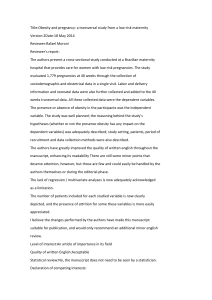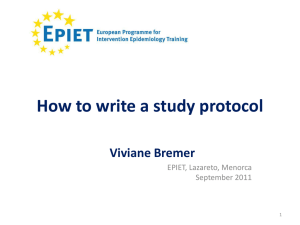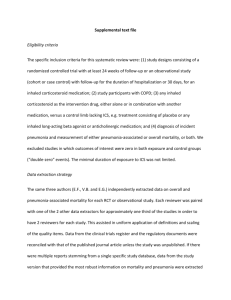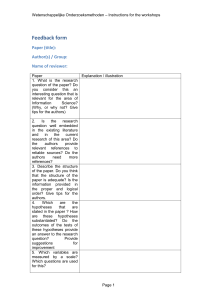Reviewer`s report Title: Molecular epidemiology of a hepatitis C virus
advertisement
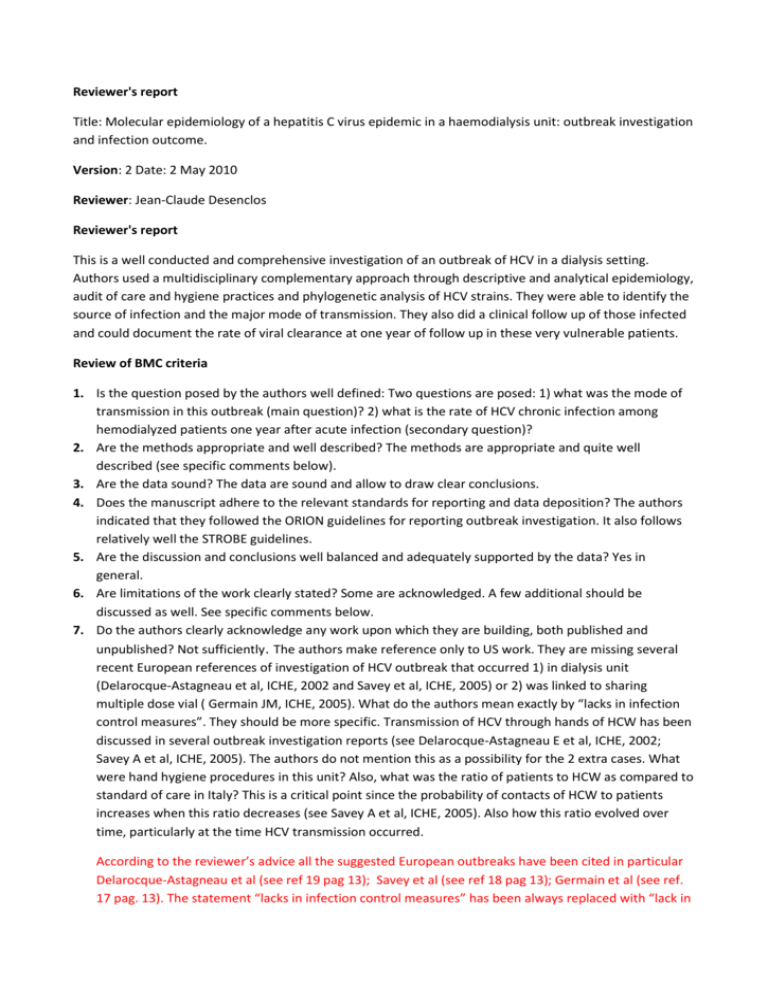
Reviewer's report Title: Molecular epidemiology of a hepatitis C virus epidemic in a haemodialysis unit: outbreak investigation and infection outcome. Version: 2 Date: 2 May 2010 Reviewer: Jean-Claude Desenclos Reviewer's report This is a well conducted and comprehensive investigation of an outbreak of HCV in a dialysis setting. Authors used a multidisciplinary complementary approach through descriptive and analytical epidemiology, audit of care and hygiene practices and phylogenetic analysis of HCV strains. They were able to identify the source of infection and the major mode of transmission. They also did a clinical follow up of those infected and could document the rate of viral clearance at one year of follow up in these very vulnerable patients. Review of BMC criteria 1. Is the question posed by the authors well defined: Two questions are posed: 1) what was the mode of transmission in this outbreak (main question)? 2) what is the rate of HCV chronic infection among hemodialyzed patients one year after acute infection (secondary question)? 2. Are the methods appropriate and well described? The methods are appropriate and quite well described (see specific comments below). 3. Are the data sound? The data are sound and allow to draw clear conclusions. 4. Does the manuscript adhere to the relevant standards for reporting and data deposition? The authors indicated that they followed the ORION guidelines for reporting outbreak investigation. It also follows relatively well the STROBE guidelines. 5. Are the discussion and conclusions well balanced and adequately supported by the data? Yes in general. 6. Are limitations of the work clearly stated? Some are acknowledged. A few additional should be discussed as well. See specific comments below. 7. Do the authors clearly acknowledge any work upon which they are building, both published and unpublished? Not sufficiently. The authors make reference only to US work. They are missing several recent European references of investigation of HCV outbreak that occurred 1) in dialysis unit (Delarocque-Astagneau et al, ICHE, 2002 and Savey et al, ICHE, 2005) or 2) was linked to sharing multiple dose vial ( Germain JM, ICHE, 2005). What do the authors mean exactly by “lacks in infection control measures”. They should be more specific. Transmission of HCV through hands of HCW has been discussed in several outbreak investigation reports (see Delarocque-Astagneau E et al, ICHE, 2002; Savey A et al, ICHE, 2005). The authors do not mention this as a possibility for the 2 extra cases. What were hand hygiene procedures in this unit? Also, what was the ratio of patients to HCW as compared to standard of care in Italy? This is a critical point since the probability of contacts of HCW to patients increases when this ratio decreases (see Savey A et al, ICHE, 2005). Also how this ratio evolved over time, particularly at the time HCV transmission occurred. According to the reviewer’s advice all the suggested European outbreaks have been cited in particular Delarocque-Astagneau et al (see ref 19 pag 13); Savey et al (see ref 18 pag 13); Germain et al (see ref. 17 pag. 13). The statement “lacks in infection control measures” has been always replaced with “lack in application of standard precautions” as defined by Sigel JD (see reference 8). Transmission of HCV through hands of HCW has been discussed (see ref 18 pag 13). Since the start of devolution process, which transfer power form central Govern to Local Authorities, in Italy each Region can make law to define minimal requirements for HD unit. In the Lazio Region the minimal requirement for HD units are defined by a regional law of 1995 (i.e.: minimum 1 doctor for 6 patients and 1 nurse for 5 patients). All these requirements were met. No change in the HCWs/patients ratio occurred after the onset of the outbreak. 8. Do the title and abstract accurately convey what has been found? Yes The abstract: why adding discussion after the conclusion? The order has been re-arranged 9. Is the writing acceptable? There are several grammatical errors that need to be corrected. English has been revised 10. Other specific comments: 10.1. Figure 2 and 3 do not bring anything important and should be ignored for the final paper. According to the reviewer’s advice these figure have been omitted. 10.2. The authors do not give criteria for the definition of an incident case. They should be more precise on this issue. Why were they not able to date incident HCV infection based on last HCV test, ALD elevation, date of PCR and HCV antibody positivity? According to both reviewers’ suggestion case definitions have been extended and now included “incident case” (see Methods section “Case definition” page 6). Date of incident HCV infection was actually based on the first HCV test positive (see methods section “Retrospective cohort study” page 5). We did not use the last negative test since each patient was tested only once every 3 months, we did not use the ALT elevation since this data was not always clearly reported in the clinical records, we could not use HCV-RNA test since patients underwent systematically HCV-PCR only by September 2005 (i.e. during the surveillance period as reported in the paper see page 5). 10.3. As the reviewer understood, the authors defined symptomatic cases as those that had elevated ALT. This is not appropriate. Patients may have elevated ALT and have no symptoms. In practice, were the authors able to document symptoms such as jaundice, fatigue, digestive symptoms, fever…among the 13 newly infected patients and, if yes, how many had really symptoms ? We were able to document none of those clinical data apart from ALT. We agree with the reviewer and change the definition “symptomatic acute hepatitis” with “incident cases with ALT>80 UI” definition of clinical attack rate has been changed accordingly. 10.4. Since the incidence rate is high the odds ratio (OR) is not an appropriate estimate of the relative risk (RR). In such a situation the OR over estimates the RR. Since the authors used a cohort study design they should report RR as the measure of association in univariate analysis. For instance, for the shift MWF-pm the univariate RR (that the reviewer calculated) is 6.95 (95% CI: 2.66-18.20 while the OR calculated by the authors is 33.75 (5.23-215.43) ! So it is recommended that authors report univariate RR and not OR. For MLR there is no other way than having OR; However, modified Poisson regression models with robust error variance allow to estimate RR in such multivariate analysis. See: Zou G. A Modified Poisson Regression Approach to Prospective Studies with Binary Data. Am J Epidemiol 2004; 159: 702-6 and Greenland S. Model-based estimation of relative risks and other epidemiologic in studies of common outcomes and in case-control studies. Am J Epidemiol 2004; 160: 301-5. I agree with the reviewer that OR is inappropriate for a cohort study now rate ratios are provided. I have carefully read the paper by Zou as suggested and I fitted another model for the analysis according to this. As you can see (Tab 2.) the results I have obtained using the “modified Poisson regression” are different from the previous one but compatible. To do this analysis I needed to change the statistical package (I have used STATA 11). The descriptions of full statistical methods are reported at page 7-8. 10.5. In the audit practice, did the authors searched for flooding of blood into the double filter on the arterial pressure tubing set. This has been described as a possible mode of transmission from patient to patient using the same dialysis machine. This is a retrospective study and we were just able to ask to HCWs and patients about the previous HD session. A systematic investigation of the unit was not done. It’s been added in limitation. 10.6. The use of Multi dose vials has been implicated in many HCV and HBV outbreaks. Why not banning them? Authors should discuss this issue. I strongly agree with the reviewer multi-dose vials have been implicated in many HCV and HBV outbreak and they should be banned. Unfortunately I believe that these devices will be used until they are banned by law as they are much more economical than mono-use device. I added it to conclusion. Level of interest: An article whose findings are important to those with closely related research interests Quality of written English: Needs some language corrections before being published Statistical review: No, the manuscript does not need to be seen by a statistician. Declaration of competing interests: 'I declare that I have no competing interests'

